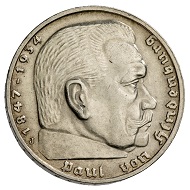Human faces, part 49: Hindenburg
courtesy of the MoneyMuseum, Zurich
translated by Teresa Teklic
Why was the human head the motif on coins for centuries, no, for millennia? And why did that change in the last 200 years? Ursula Kampmann is looking for answers to these questions in her book “MenschenGesichter” (“Human faces”), from which the texts in this series are taken.
Germany. Third Reich. 5 reichsmark 1938. Eagle, wings spread, on wreath with swastika. R. Head of Paul von Hindenburg, facing right. Edge lettering (in translation): “The common good before the individual good”. © MoneyMuseum, Zurich.
Open any book about the Third Reich and you will find a photograph in there, taken on 21 March 1933, the day of the Machtergreifung (seizure of power). Standing on the left is 86-year-old President von Hindenburg, on his head a spiked helmet, on his side a sabre. Adolf Hitler is shaking his hand, bowing deeply before this great man, the embodiment of Prussian tradition. Who was this Hindenburg, the man who would turn out to be the precursor of the Führer?
Paul von Beneckdorff und Hindenburg, which is his full name, born in 1847, had already retired at the outbreak of World War I. He volunteered and was sent to the east front, where he scored a few important but in no way decisive victories. Still, Hindenburg remained one of the few German generals who had won any victories at all. On these grounds, he was made supreme commander in 1916. In his position as such, he wrote to the government on 2 October 1918 that a total defeat was not unthinkable should the allies attack again. He refused to take on any responsibility in this case. It was not least because of this that the Reichskanzler (chancellor) entered into peace negotiations.
Still, by November 1919, Hindenburg had already forgotten what he had said the previous year. The 72-year-old read out a declaration before the commission that was investigating the causes of the defeat. The victorious battle front – that was his message – had been “stabbed in the back” by the November Revolution. It seems that after this the old man was more than ready for his retirement. But once more, in 1925, the fatherland called or, more precisely, the right-wing parties, which considered Hindenburg the only promising presidential candidate in their own ranks. As always the 78-year-old did what he believed to be his duty, became the figurehead of the right, and was even re-elected in 1932, now aged 85.
Burial of Paul von Hindenburg in the central yard of the Tannenberg Memorial, 1934, and speech by Adolf Hitler. Source: Bundesarchiv, Bild 183-2006-0429-502 / CC-BY-SA.
It was Hindenburg’s luck that he died already on 2 August 1934 and thus did not have to witness what kind of regime he had paved the way for. Though perhaps the National Socialist agenda would not have been so far from his own. Be that as it may, those in power still exploited the prestige of the old general in 1936 to spread their propagandistic slogan (in translation) “The common good before the individual good” on the new 5-reichsmark pieces.
That same year, German troops violated the peace treaty by occupying the Rhineland and began to build their so-called Thousand-Year Reich on the ashes of Germany.
The next and last episode in this series is dedicated to Italian poet Dante Alighieri and his enormously important role in Italy’s history.
You can find all episodes in the series here.
A German edition of the book “MenschenGesichter” is available in print and as ebook on the site of the Conzett Verlag.











